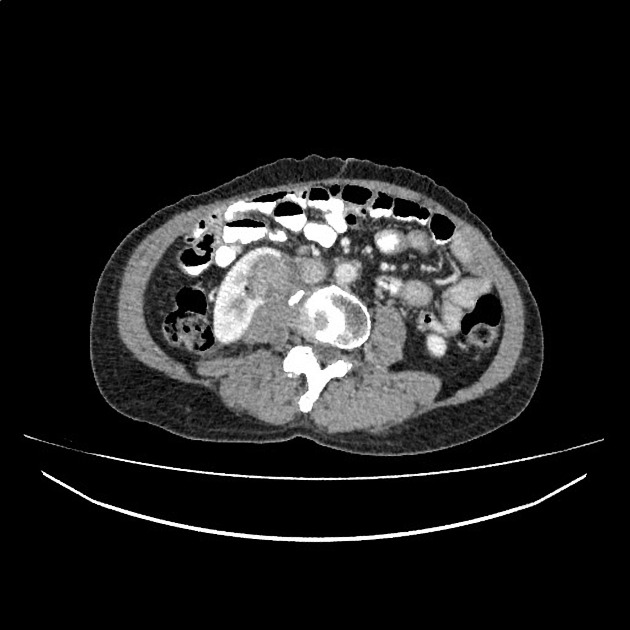Dedifferentiated liposarcoma

Dedifferentiated liposarcomas (DDLPS) are malignant adipocytic soft tissue neoplasms that have progressed from primary or recurrent atypical lipomatous tumors/well-differentiated liposarcomas and are characterized by a much higher rate of recurrence, metastasis in about ¼ of the cases and a much higher overall mortality.
Epidemiology
Dedifferentiated liposarcomas are the result of dedifferentiation of well-differentiated liposarcomas, happening in about 10%, and in most of the cases coexists with the latter. Most commonly they occur in the 7 decade of life with women and men being equally affected. In the retroperitoneum, dedifferentiated liposarcomas account for most pleomorphic sarcomas .
Clinical presentation
The most common presentation is that of a large painless mass, which might be found incidentally .
Complications
If left untreated dedifferentiated liposarcoma will progress locally and can metastasize to distant organs .
Pathology
Dedifferentiated liposarcomas are usually biphasic neoplasms characterized by features of any subtype of well-differentiated liposarcomas with more or less abrupt transitions to highly cellular regions of higher-grade spindle cell or pleomorphic non-fatty sarcoma-like tumor components .
Location
Dedifferentiated liposarcomas most frequently involve the retroperitoneum and less frequently the deep soft tissue locations of the extremities and other body regions as the head/neck region, the paratesticular area or the mediastinum .
Macroscopic appearance
Macroscopically dedifferentiated liposarcomas are usually large multinodular tumors with solid non-fatty tannish colored portions and lipomatous yellow parts with gradual or abrupt transition zones .
Microscopic appearance
The microscopic appearance of dedifferentiated liposarcomas includes the following features :
- variable histological picture
- abrupt or gradual transition zones
- uniform fibroblastic spindle cells with mild nuclear atypia (low-grade)
- morphology resembling undifferentiated pleomorphic sarcoma or myxofibrosarcoma
Immunohistochemistry
Immunohistochemistry stains are usually positive MDM2 and/or CDK4 .
Genetics
Genetically dedifferentiated liposarcomas show a significant overlap with atypical lipomatous tumors/well-differentiated liposarcomas and involve MDM2 nuclear gene amplification .
Radiographic features
A common radiological feature of dedifferentiated liposarcomas is the coexistence of lipomatous and solid non-fatty components .
- size > 5 cm
- nodular non-fatty tissue components > 1cm
- more than 1/4 of solid non-fatty tissue in a lipomatous tumor
- multinodular tumor margins
They might displace other organs or tissue.
Ultrasound
Usually appears as multilobulated with areas of low echogenicity .
CT
CT usually shows a fat tissue density mass with thick or nodular enhancing areas. Calcifications might be found .
MRI
On MRI dedifferentiated liposarcomas will display a mass with fatty and juxtaposed non-fatty components. The non-fatty components appear heterogeneous with contrast enhancement .
- T1: hypointense signal of the non-fatty component
- T2: heterogeneous hyperintense signal of the non-fatty component
- T1 C+ (Gd): enhancement of the solid non-fatty components
Radiology report
The radiological report should include a description of the following:
- form, location and size
- tumor margins
- amount of non-adipose tissue
Treatment and prognosis
The management of dedifferentiated liposarcomas includes resection with a local recurrence of about 40% in a local recurrence in nearly all cases of retroperitoneal tumors if patients are observed over a longer time period like 10-20 years . Distant metastases happen in 15-20% of the cases.
Mortality is about 28-30% after five years and much higher after a 10-20year period .
Similar to well-differentiated liposarcomas the tumors are not particularly sensitive to radiotherapy or chemotherapy .
Differential diagnosis
Conditions or tumors which can mimic the presentation and/or the appearance of include :
- intramuscular lipoma
- atypical lipomatous tumors/well-differentiated liposarcomas
- myxoid liposarcoma
- pleomorphic liposarcoma
- myolipoma of soft tissue
- angiomyolipoma
- teratoma
See also

